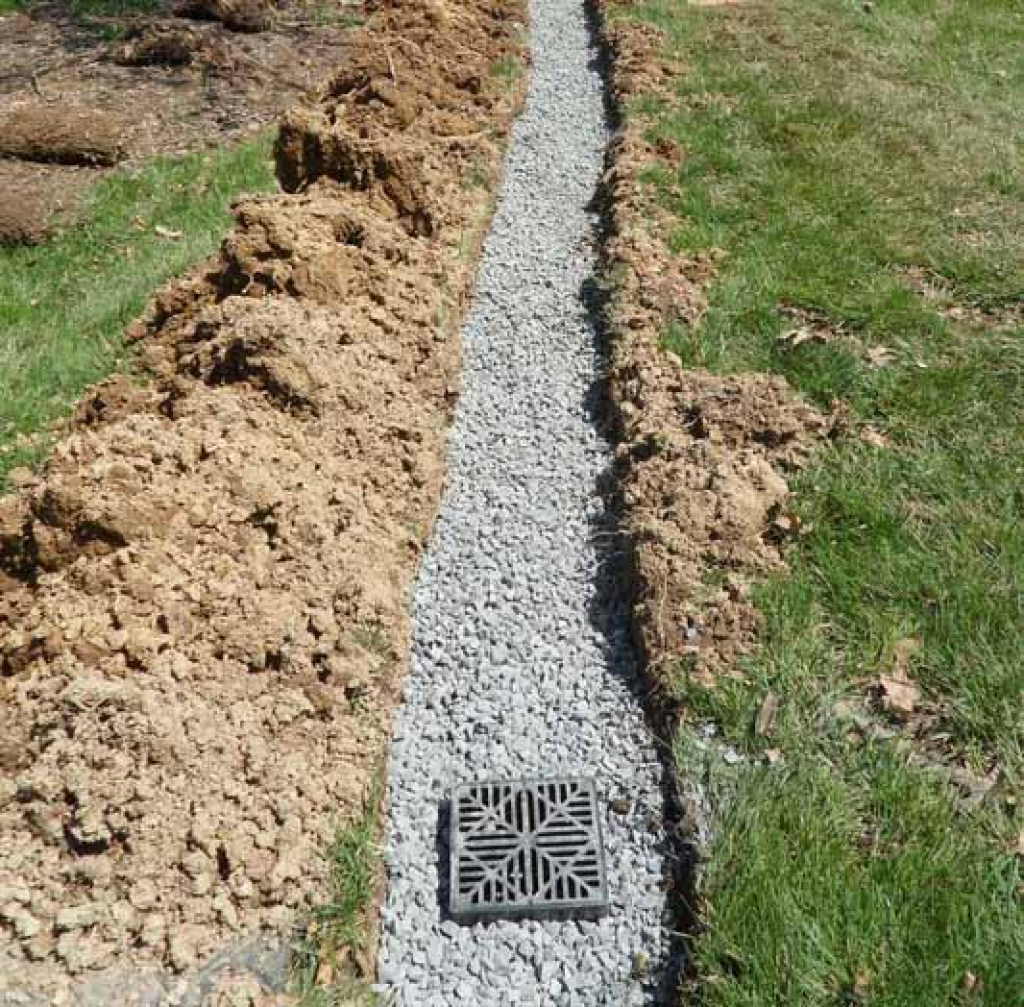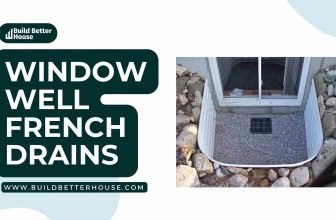How to Determine The French Drain Distance From House?

If you have a wet lawn or a basement in your residence, you should consider the installation of a French drain. Keeping your yard or basement dry will be perceived as a wise investment. But the question is, what should be the french drain distance from house?
French drains work best when installed at the optimum distance and slope to take water away from the property. Determining the right french drain distance from house is essential for successful installation; failing to do so could result in more damage to the basement.
This article will tell you how to determine the proper french drain distance from house and how to install one. Let’s continue to know about it below.
What Is a French Drain?
A French Drain is a pipe that gathers excess water from low places in the earth and transfers it to a designated downhill area.
A perforated pipe with a large diameter is installed in the ground to collect surplus water and drain it away from the damaged portions of the ground.
The channel or drain is frequently filled with perforated pipes, gravel, and filters. This drain allows unwanted water to pass through the perforated pipe and keeps you safe at home.
How Does A French Drain Work?
Flowing water always follows a straight line to the lowest point, and when it gets to the empty areas, it moves the loose soil into them, which is where French drains come into play.
The french drain provides a safe path for the water to flow over and through. Water flows down the drain or channel, filled with gravel, and finally into the perforated pipe at the bottom. Water flows freely down the tube and is released safely from the home’s basement.
The drain’s bottom will be slanted 1 inch every 8 feet to ensure the water flows properly. Depending on the position of the ground area, the water might be routed to the street, drywall, or drainage trench.
It is advisable to install a french drain by determining the proper distance from the house, where water can pool and sit for hours or days, even after heavy rains.
How to Find the Right French Drain Distance From House?
Determine where surface water naturally collects during periods of heavy rain before deciding on the ideal french drain distance from house. It is critical to locate french drains in flood-prone areas as their purpose is to transport water away from the house, beginning at a higher elevation. .
Install the french drain considering the proper french drain distance from house’s foundation.
When installing an outside French drain, ensure that gutters are taken into account to enable. Draining the water too close to the house is also a bad idea since the water could damage the foundation and cause long-term structural issues.
Use spray paint to indicate the location of the drain after measuring the distance all around the home, including the porch and basement. Even if you’re constructing a french drain between two properties, keep a safe space between them.
French Drain Distance from Foundation
A french drain should be installed 3 to 4 feet from the foundation. This ensures that the french drain distance from house is far away, not to cause any harm while being close enough to be effective.
Another crucial factor is that French drains should not be put in a straight line from the foundation. This may result in erosion and water pooling around the foundation.
Finding The Proper Distance
Use a measuring tape to evaluate how far the water is receding from the base of the foundation to establish the appropriate french drain distance from house. The French drain will only catch some water if it is close to home.
In the same way, if the french drain distance from house is too close, it may eventually cause damage to the house.
How to Know If You Need A French Drain?
When you have a water problem at your house, you will realize that you require a French drain on your lawn.
You should consider installing a French drain if you see the following signs:
- When you notice water entering your basement in your home.
- When you suspect your home’s exterior water is a problem.
- When you want to build a retaining wall on a slope.
A French drain resolves the water problem by directing it to lower locations, the streets, the channel or drain, the dry well, or other areas.
How to Install a French Drain?
Before constructing a French drain, you must decide the right slope for your yard’s soil and the distance of the drain from home. In general, you should allow for a slope of about one inch for every eight feet of drainage pipe length.
Before beginning the project, you must notify your local board of officials or government office. Even minor earth-moving projects may necessitate numerous approvals from the various governmental organizations in your area.
Before digging, check with your neighbors to see if you can dig on their property.
Step 1: Determine The Right French Drain Distance From House
Before starting the installation process, you must first plan your french drain distance from house and design it appropriately.
As discussed before, it is essential to maintain a safe french drain distance from house since installing one too far or too close may cause damage to your house.
When you’ve decided on a location, note where you’ll put the French drain.
Spray paint can use to mark the place conveniently.
Step 2: Construct a French Drain Trench

It’s time to dig the trench after you’ve decided on the proper french drain distance from house or the right location to install the system. You can create one if you still need a sloped yard. You can make do with a hand shovel.
Even though the depth of the trench isn’t specified, professionals suggest that it should be at least 1.5 feet deep to function correctly.
Step 3: Attach Fabric Lining To Trench
A piece of fabric must cover the trench’s bottom and walls. This cloth liner will aid soil retention and keep the pipe from clogging.
After laying down the cloth, you may begin installing the french drain.
Step 4: Arrange landscaping stones in the canal over the lining
Spread the fabric out first, then add a gravel layer on top. The stone serves as a solid foundation for the drainage pipe. This layer prevents grass and debris from entering the tube. To keep the gravel from shifting, compact it first.
After placing the gravel, add extra fabric to the trench’s bottom. When laying down bedding, ensure it can withstand the plumbing and drain and use a high-quality landscape cloth or sand.
Otherwise, your drainage system will be inadequate.
Step 5: Connect The Pipe System
The following step is to connect a pipe into the trench over the gravel bed.
Use an inexpensive, flexible draining hose if you need a curved drain, or PVC pipes, which endure longer if you want a more durable solution. If you choose the latter, drill holes along the pipe’s length about 6 inches apart.
Place your PVC pipe or hose into the trench over the cloth liner.
Step 6: Cover The Trench With More Gravel
After you’ve laid the pipe and fitted all of the french drains, you’ll need to cover the line with limestone similar to the ones you used as a base in the trench.
Step 7: Arrange the excess fabric lining
Then, with the remaining fabric liner, wrap it around the pipe so that no portion is exposed.
If you use perforated pipes, you will not need to do this step; instead, the pipe will be covered with gravel.
Step 8: Cover the trench and fill it in
The only thing left to do is to fill in the trench. You can use the same soil you removed for this and decorative stones to avoid loose soil after refilling the trench.
Conclusion
Installing a French drain is easy if you know all the facts. You can easily install a french drain by following the procedures above, and all you have to care about is the proper french drain distance from house.
Install it on your property to drain water to keep your lawn and basement dry. If you live in an area where rain and storms are often, this is an excellent investment for your property. In addition, various other water discharge alternatives are available depending on your land type.
What are the reasons for French drain failures?
As soil and clay granules enter the trench through landscape fabric, French drains can become clogged. They eventually accumulate inside the pipe, reducing its ability to drain water. Despite using a filter cloth, roots from nearby trees and shrubs can still enter the French drain.
How Much Does a French Drain Installation Cost?
As they require more labor, interior French drains are more expensive than external drains. Excavating through a concrete floor is necessary when installing an inside French drain.
Installing a French drain at home costs between $5,000 and $13,500. Most basements necessitate a 100-150-foot French drain. An outdoor French drain will cost between $10 and $50 per linear foot, whereas an inside drain will cost between $40 and $100 per linear foot.
Which is preferable, an interior or an exterior French drain?
Interior and exterior French drains are good drainage systems for protecting your basement from flooding and water damage. Although interior drains require more labor to construct, they are easier to maintain since they are not obstructed by debris or plants and bushes. Exterior French drains are difficult to repair and maintain, in addition to being challenging to install.
Is a Sump Pump Required If You Have French Drains?
It depends on the amount of water in your basement and nearby areas. If you have excess water in your basement, consider installing a sump pump and a French drain to eliminate it. The two options use different methods to drain the water.
A French drain transports water to the sump pump pit, which is pumped out of the house. This is a significantly faster-draining procedure than any of the others.
FAQ
What are the reasons for French drain failures?
As soil and clay granules enter the trench through landscape fabric, French drains can become clogged. They eventually accumulate inside the pipe, reducing its ability to drain water. Despite using a filter cloth, roots from nearby trees and shrubs can still enter the French drain.
How Much Does a French Drain Installation Cost?
As they require more labor, interior French drains are more expensive than external drains. Excavating through a concrete floor is necessary when installing an inside French drain.
Installing a French drain at home costs between $5,000 and $13,500. Most basements necessitate a 100-150-foot French drain. An outdoor French drain will cost between $10 and $50 per linear foot, whereas an inside drain will cost between $40 and $100 per linear foot.
Which is preferable, an interior or an exterior French drain?
Interior and exterior French drains are good drainage systems for protecting your basement from flooding and water damage. Although interior drains require more labor to construct, they are easier to maintain since they are not obstructed by debris or plants and bushes. Exterior French drains are difficult to repair and maintain, in addition to being challenging to install.
Is a Sump Pump Required If You Have French Drains?
It depends on the amount of water in your basement and nearby areas. If you have excess water in your basement, consider installing a sump pump and a French drain to eliminate it. The two options use different methods to drain the water.
A French drain transports water to the sump pump pit, which is pumped out of the house. This is a significantly faster-draining procedure than any of the others.
Related Articles
Sump Pump Installation: Complete 9-Step Process For Beginners
Sump Pump Tripping Breaker: What You Need to Know?
No sump pump in the basement? Don’t worry!






